Mauritania << `mawr` ih TAY nee uh >> is a country in northwestern Africa. It stretches eastward from the Atlantic coast into the Sahara. Arabic-speaking people called Moors make up most of the population. Most Mauritanians are Muslims.
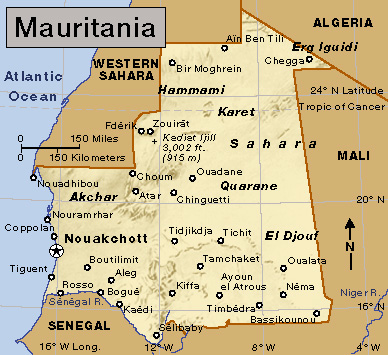
Mauritania was once a colony in French West Africa. It became independent in 1960. The full name of the country is the Islamic Republic of Mauritania. Nouakchott is the capital and largest city.
Government.
Under the Constitution, the president serves as head of state. The president is elected by popular vote to a five-year term and cannot serve more than two terms. A prime minister serves as head of government. The president appoints the prime minister. The president also appoints the Council of Ministers on the recommendation of the prime minister. Mauritania’s legislature consists of a National Assembly elected by the people. Mauritania is divided into 15 regions for purposes of local government. Each region is governed by a council whose members are elected by the people.
People.
The majority of people are Moors, descendants of Arabs and Berbers. Most Moors speak an Arabic dialect called Hassaniya. Some lead a nomadic life, living in tents and moving over the desert with their cattle in search of waterholes and pastureland. Others live in cities, in villages, or in rural areas where they farm. 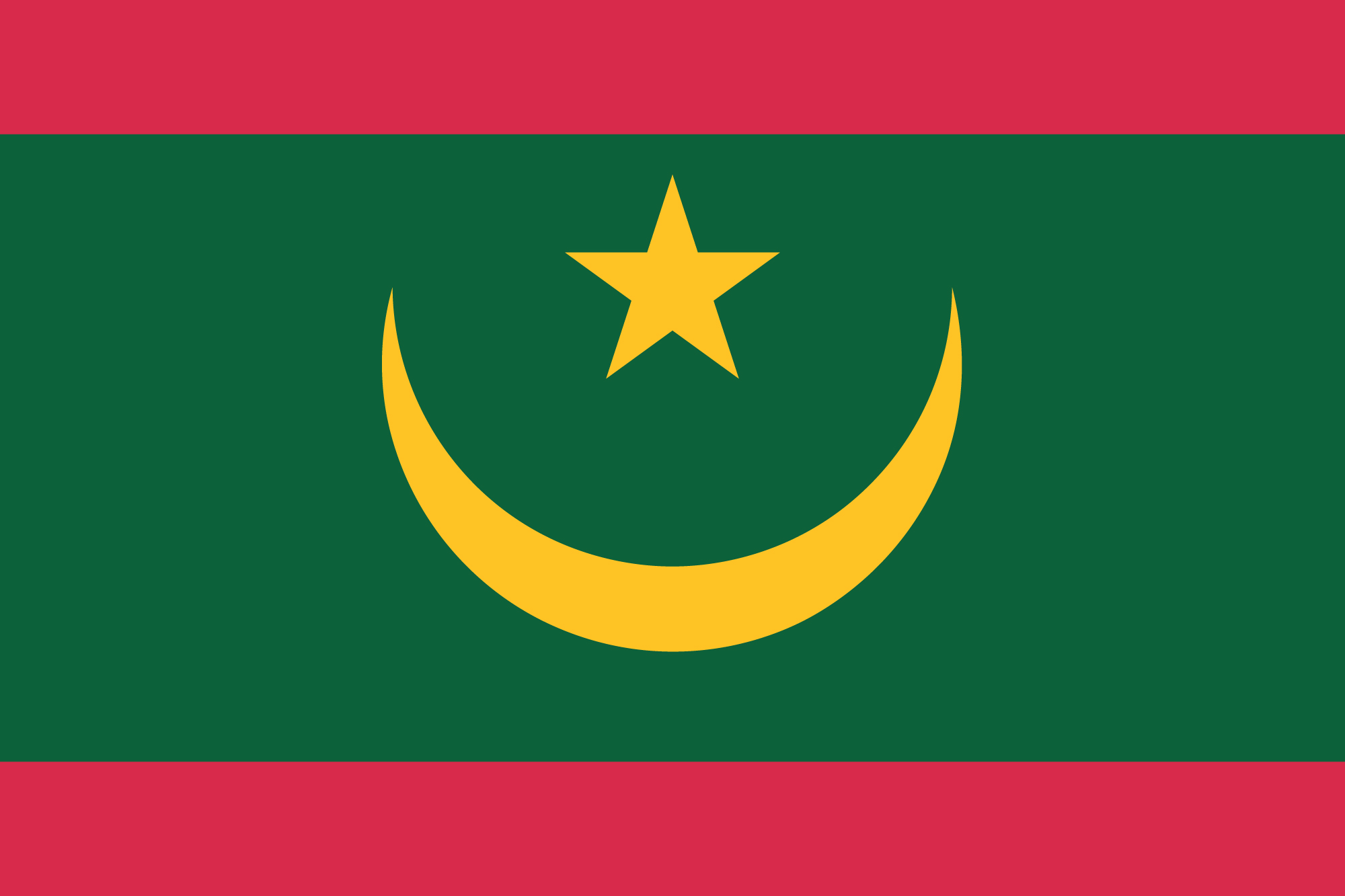
The Moors are divided into two main groups, white Moors (also called Bidan) and black Moors (also called Haratine). The terms white and black refer to social status and family lineage rather than to skin color. The white Moors have the higher status. Traditionally, the white Moors have been divided into two classes: warriors and religious leaders. Until the early 1900’s, the warriors were a noble class who strove for political dominance. Other classes served the warriors, whose chief occupation was fighting. Religious leaders have always raised cattle, sheep, and other livestock. They traditionally have been an educated class whose members have advised the warriors. They have also paid the warriors for security services. Both groups kept black slaves. Loading the player...
Mauritania's national anthem
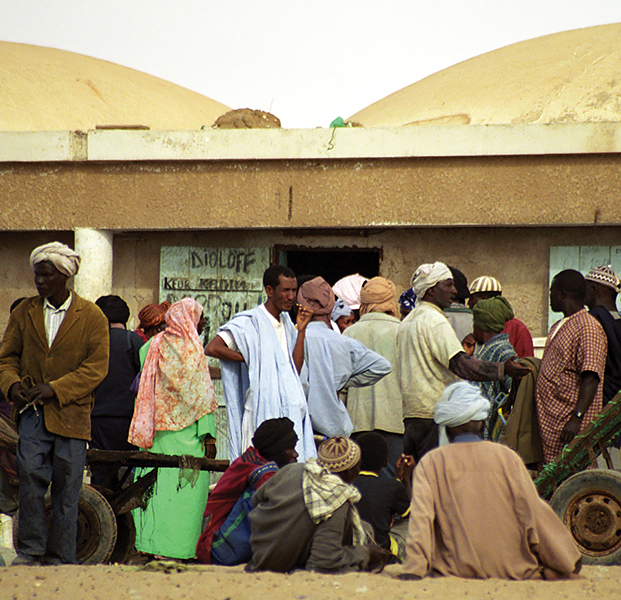
About a third of Mauritania’s people are black Africans belonging to any of several ethnic groups. Many are farmers who live in villages along the Sénégal River. Their circular houses, with walls made of sun-dried mud brick, stand along narrow, twisting village pathways. The largest black ethnic group is the Toucouleur. The Fulani, the Soninké, the Wolof, and the Bambara are some other groups. The blacks were the first to gain a modern education under French rule during the early and middle 1900’s. Many hold jobs in government or as teachers.
Mauritania has two main languages, Arabic and French, used extensively in government and education. Black ethnic groups also speak their own languages. Disputes over language use have broken out over the years. In 1991, Arabic became the country’s official language. At the same time, Arabic and three black languages—Poular, Soninké, and Wolof—were recognized as national languages. Both Moors and blacks promote their own interests in language and other matters. 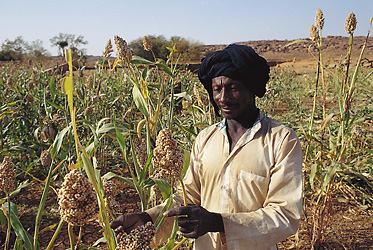
Only about half of Mauritania’s children complete primary school, and less than a fifth attend high school. The country’s first university, the University of Nouakchott, was founded in 1981.
Land.
An imaginary line drawn between Nouakchott on the coast and Néma in the southeast divides Mauritania into two major land regions. The Sahara covers most of the area north of the Nouakchott-Néma line. It is broken only by rocky plateaus and a few oases.

The small part of the country south of the line contains two fertile areas—a narrow plain along the Sénégal River and a savanna (grassland with scattered trees) in the southeast. Farmers grow millet, rice, and other crops on the plain. Herders raise livestock in the savanna area. Most people live in the south.
Mauritania’s climate is hot. But desert temperatures may fall from over 100 °F (38 °C) during the day to 45 °F (7 °C) at night. The average monthly temperatures at the coastal city of Nouadhibou vary from a 91 °F (33 °C) high in September to a 54 °F (12 °C) low in January. There is little rain in the north. Southern Mauritania receives over 20 inches (51 centimeters) of rain a year.
Economy.
Mauritania is a poor and underdeveloped country. It has a high unemployment rate, and many of its people live in poverty. The government depends on aid from other countries to balance its budget.
Mauritania’s economy is largely based on agriculture. About half of the people are farmers and livestock herders. Important livestock products include beef and dairy cattle, goats, and sheep. Herders also raise camels. Farmers grow corn, dates, millet, rice, and sorghum. They also raise acacia trees for gum arabic. Rich fishing waters lie off the coast.
High-grade iron ore deposits near Fdérik are one of Mauritania’s most important mineral resources. The ore accounts for much of the country’s export income. Mauritania also benefits from offshore oil deposits.
Most of Mauritania’s roads are unpaved. Nouadhibou is the country’s chief port. International airports operate at Atar, Nouadhibou, and Nouakchott.
History.
From the A.D. 300’s to the 1500’s, some areas of what is now Mauritania were part of three great west African empires— Ghana, Mali, and Songhai. In the early 1900’s, archaeologists identified ruins in southeastern Mauritania as part of Kumbi Saleh, the last capital of the Ghana Empire.
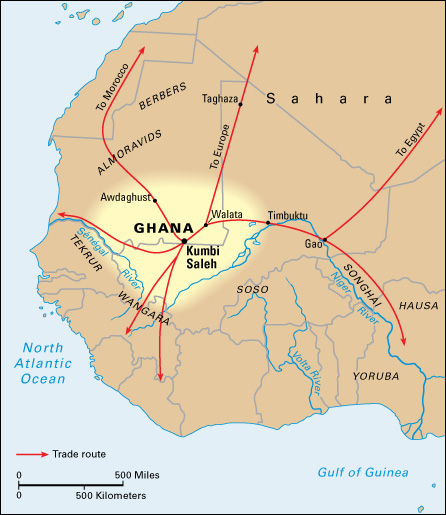
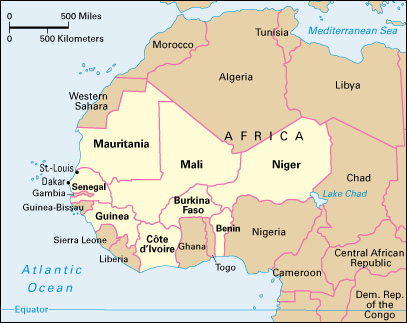
In the mid-1000’s, the Berber-speaking Sanhaja people established a political community inspired by the leaders of a ribat (religious settlement). The group became known as al-murabitun (men of the ribat). The term became Almoravids through a Spanish mispronunciation. The Almoravids eventually controlled the northwestern corner of Africa and the southern parts of what are now Spain and Portugal. The group ruled until about 1147.
The Portuguese landed in Mauritania in the 1400’s, but continuous European contact did not begin until the 1600’s. From the 1600’s to the 1800’s, France, the Netherlands, and the United Kingdom competed for the Mauritanian gum arabic trade.
France began to occupy Mauritania in 1902 and set up a protectorate there in 1903. Xavier Coppolani was the first governor. Modern Mauritania is largely the result of Coppolani’s work in promoting Mauritanian identity separate from nearby states and of his successors’ ability to extend French rule over the country. Mauritania became a French colony in 1920.
In 1946, Mauritania became a territory in the French Union, an organization that linked France and its overseas territories. In 1958, Mauritania became a self-governing republic in the French Community, a group of independent countries and other political units that succeeded the French Union. Mokhtar Ould Daddah was elected prime minister in 1959. Supported by many Moorish leaders and educated blacks, he favored independence and close ties with west African countries.
On Nov. 28, 1960, Mauritania became independent. However, Morocco did not recognize its independence, claiming that Mauritania was historically Moroccan territory. Some of Ould Daddah’s opponents went to Morocco and worked to unite the two countries. Morocco finally recognized Mauritania’s independence in 1970.
In 1961, Mauritania adopted a constitution that set up a presidential system of government. Ould Daddah, elected the first president, merged Mauritania’s four political parties into a single party, the Mauritanian People’s Party. A 1965 constitutional amendment officially made Mauritania a one-party state.
In 1976, Spain gave up control of Spanish Sahara, and Mauritania and Morocco took over its administration. This area—which borders Mauritania, Morocco, and Algeria—is now called Western Sahara. Mauritania claimed the southern part, and Morocco claimed the northern part. Algeria and an organization of Western Saharans called the Polisario Front opposed the claims. Fighting began between the Polisario Front and troops from Mauritania and Morocco. In 1978, military leaders overthrew Ould Daddah and took over the government. In 1979, Mauritania gave up its claim to Western Sahara and ended its role in the fighting.
In 1991, Mauritania legalized political parties. In 1992, Maawiya Ould Sid Ahmed Taya, an army colonel who had been president of the military government, was elected president. Opposition parties boycotted the 1992 parliamentary elections. But in elections held in 1996, members of parties other than the progovernment Republican Democratic and Social Party gained seats in the national legislature. Taya was reelected president in 1997. In 2003, rebel soldiers tried to overthrow Taya, but they failed. He was reelected president later that year.
In 2005, a group of army officers succeeded in overthrowing Taya while he was out of the country. The officers established a Military Council to temporarily rule Mauritania. In 2006, voters approved, in a referendum, constitutional amendments limiting presidential terms.
In November and December 2006, Mauritania held local and National Assembly elections, its first fully democratic elections since independence. In a March 2007 presidential election, Sidi Ould Cheikh Abdallahi, a former cabinet minister, was elected president. In August, President Abdallahi attempted to dismiss some of the army’s top commanders. The commanders, led by General Mohamed Ould Abdel Aziz, responded by arresting the president and prime minister and taking over the government. The African Union and many countries around the world condemned the take-over, but Aziz was elected president of Mauritania in elections held in 2009 and again in 2014. In 2017, voters approved a referendum that abolished Mauritania’s Senate. In 2019, voters elected a new president, Mohamed Ould Ghazouani, the candidate of the ruling party. The election marked the first peaceful transfer of power in Mauritania since the country gained its independence in 1960. In 2021, Aziz was arrested on corruption charges following a parliamentary investigation.
